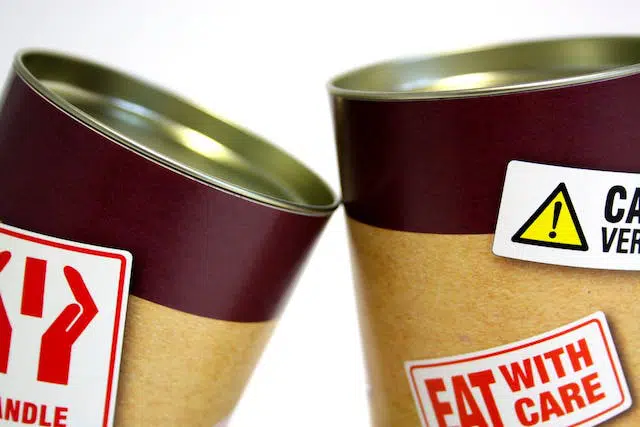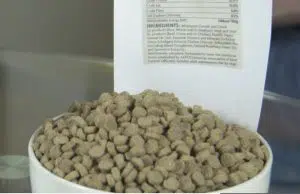

The pet food industry in Australia is self-regulated, meaning it’s up to the pet companies themselves to choose whether they comply with the Australian Pet Food Manufacturing and Marketing Standards or not. As a result, it can be difficult to know what you should be looking for in a pet food label.
To help in the longer term, the Government is holding an inquiry into the pet food industry, but for now, it‘s up to us consumers to do a little extra research when choosing the right food for their pets and knowing what to look for on the pet food label.
If you’re looking for a more natural pet food and aren’t sure how to decipher the claims and information on the pet food label, here are few questions to ask and tips to help.
Where is the protein coming from?
Our pets need protein as a far greater percentage of their diet than us humans do. Protein in pet food generally comes from three main sources. Real meat, meat meals and by-products, as well as plants. The quality and completeness of these protein sources varies greatly.
Protein from ‘real’ meat is the highest quality, and the least processed form of protein and, therefore, is definitely the most natural.
What‘s the shelf life?
Would you be interested in eating a meat product that’s been in a bag in your pantry for two years? Probably not. So, if you’re looking for the most natural diet to feed your pet then long shelf lives should raise some questions in your mind…and for good reason.
Pet foods in bags, cans or “fresh” food that can be refrigerated for long periods of time without going off, must have some form of preservatives or preservations methods used as part of their processing. These may impact their nutritional value to your pet and certainly means they aren’t 100% natural.
Fresh, 100% natural ingredients only stay fresh for a short time, in line with our human food ingredients, before they need to be frozen to extend their shelf life. If you want the most natural diet for your pet, prepare their diet yourself with the key ingredients in the right amounts. Then freeze it until required for thawing prior to feeding. Or look for a frozen diet in your local pet food store that has done all the work for you.
Starches and simple carbohydrates are your best friend’s enemy
Energy from food can only come from three sources; protein, fat and carbohydrates. Many forms of carbohydrates used in pet foods are processed starches which are metabolised like sugar in your pet’s body. Think of these diets like your diet if you ate take-away junk food for every meal, every day of the week. You wouldn’t expect to be healthy, right?
If you’re interested in helping your pet get more fresh, natural food in their diet, steer clear of starchy carbohydrate foods and look for ingredients rich in fibre like fresh vegetables and fruits. Just make sure they’re mulched for your pet so their systems can utilise the goodness in them, as feeding them in chunks, rather than the pulp, means they won’t be absorbed and will go straight through them. Read more about that here.
All natural should be easily discernible on the pet food label
Because there is no regulatory body making sure pet food companies are toeing the line when it comes to their marketing claims, it can be hard to discern what’s true on the pet food label, from what’s just tricky lingo.
Terms like “contains natural” may mean there is a little bit of a natural occurring ingredient in the food, but it may not be much.
“Naturally sourced / harvested or occurring” may mean that an ingredient was naturally sourced once upon a time, but since then, the ingredient may have gone through processing, so therefore isn’t actually in a natural state anymore.
The best thing to look for the clear terms that state they are 100% natural and contain no synthetic ingredients, and that they don’t have a long shelf life as discussed above.
Of course, actually reading through the list of ingredients will help. If you see a list of words that looks like they belong in a science lab, more than in a food product, chances are there isn’t much that is truly natural about that product.
If all else fails, call the company
One of the biggest criticisms by the Australian public of the Australian pet food industry is that they are nameless, faceless corporations who are completely inaccessible and won’t provide any information about their food or processes. Information that is critical to our decision-making process when it comes to choosing the right food for our pets.
While no pet food company will give you their exact recipes for their food, you should be able to get the following information to make an informed decision:
The Australian Government is working towards a more transparent pet food industry to help raise the bar and increase consumer confidence and trust in pet food manufacturers. In the meantime, this guide will help serve you to get some of this information yourself from a pet food label, and be able to choose a company you can trust.
A food science graduate, Chris Essex founded Big Dog Pet Foods in 2000 after many years working in the smallgoods industry, before he recognised a gap in the market to create pet food for dogs made up of bones and raw food that was full of nutritional ingredients. Visit www.bigdogpetfoods.com

Exercising puppies – how much do they need?

Carbohydrates in dog food – what you need to know


What to feed a dog at each life stage
